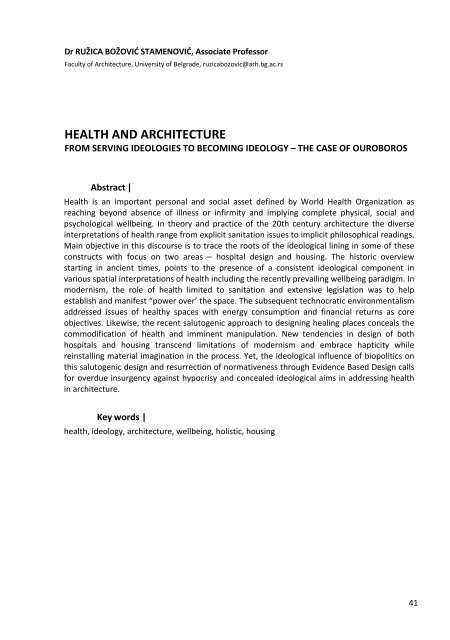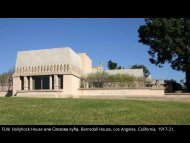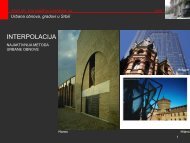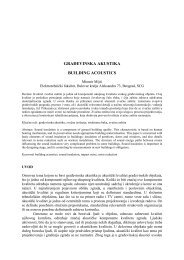Architecture and Ideology
Architecture and Ideology
Architecture and Ideology
You also want an ePaper? Increase the reach of your titles
YUMPU automatically turns print PDFs into web optimized ePapers that Google loves.
Dr RUŽICA BOŽOVIĆ STAMENOVIĆ, Associate Professor<br />
Faculty of <strong>Architecture</strong>, University of Belgrade, ruzicabozovic@arh.bg.ac.rs<br />
HEALTH AND ARCHITECTURE<br />
FROM SERVING IDEOLOGIES TO BECOMING IDEOLOGY – THE CASE OF OUROBOROS<br />
Abstract |<br />
Health is an important personal <strong>and</strong> social asset defined by World Health Organization as<br />
reaching beyond absence of illness or infirmity <strong>and</strong> implying complete physical, social <strong>and</strong><br />
psychological wellbeing. In theory <strong>and</strong> practice of the 20th century architecture the diverse<br />
interpretations of health range from explicit sanitation issues to implicit philosophical readings.<br />
Main objective in this discourse is to trace the roots of the ideological lining in some of these<br />
constructs with focus on two areas – hospital design <strong>and</strong> housing. The historic overview<br />
starting in ancient times, points to the presence of a consistent ideological component in<br />
various spatial interpretations of health including the recently prevailing wellbeing paradigm. In<br />
modernism, the role of health limited to sanitation <strong>and</strong> extensive legislation was to help<br />
establish <strong>and</strong> manifest “power over’ the space. The subsequent technocratic environmentalism<br />
addressed issues of healthy spaces with energy consumption <strong>and</strong> financial returns as core<br />
objectives. Likewise, the recent salutogenic approach to designing healing places conceals the<br />
commodification of health <strong>and</strong> imminent manipulation. New tendencies in design of both<br />
hospitals <strong>and</strong> housing transcend limitations of modernism <strong>and</strong> embrace hapticity while<br />
reinstalling material imagination in the process. Yet, the ideological influence of biopolitics on<br />
this salutogenic design <strong>and</strong> resurrection of normativeness through Evidence Based Design calls<br />
for overdue insurgency against hypocrisy <strong>and</strong> concealed ideological aims in addressing health<br />
in architecture.<br />
Key words |<br />
health, ideology, architecture, wellbeing, holistic, housing<br />
41
















